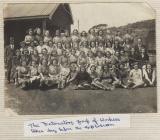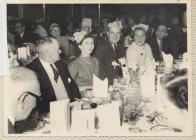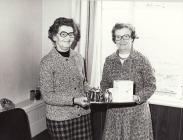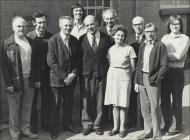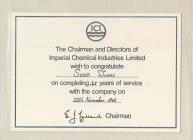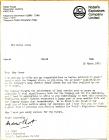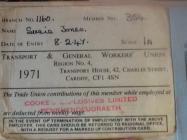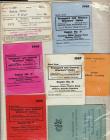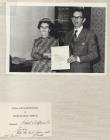Susie Jones , Voices from the Factory Floor
Items in this story:
Susie started work in the powder factory in November 1933, a few days after her fourteenth birthday. She had worked as a maid when she was in school for thruppence a week and had then been told about a similar job in Bethesda. However, her mother was a widow with four children and in poor health. It made sense that Susie, being a girl, was on hand to help out. Her older brother had sailed to Canada on a Salvation Army scheme at the age of 16. She preferred to go to work in the local factory.
Her mother was born in Llanfrothen. Susie went to school at Maenofferen. When her father had died she’d had to move to Ro Wen, Conway to live with his family, and had attended school there for a while. By the time she returned home, her family had moved to Penrhyndeudraeth, and she attended Penrhyn school circa 1928. Her sister was 11 months old when her father died.
Susie had worked as a maid for Miss Rees, who was the housekeeper at Hyfrydle for her widower brother Tom Rees, a clerk at Minffordd station. They had two other brothers – a Doctor Rees and Ifan Rees who was a dramatist. Miss Rees sold Spirella corsets door-todoor from a suitcase.
4.05
Susie got a job in the factory which was divided into Mining Safety Explosives and Cooke’s. The youngest workers started in the detonators department and Susie recalls an incident when one worker’s promotion to another department caused consternation and a deputation set-off towards the office to complain. However, when she reached the office door, Susie realised she was suddenly alone. Mr Lovett (management) said: “I don’t think much of your supporters Susie.”
The Miners Office was at one end near the gate – the Time Office on the left and the Main Office on the right.
There were 10 workers in the wire room, more than 20 in the next section and small individual cells for handling detonators. In the packing area there were 5-6. It was quite an entertaining time, singing together and telling stories and tales about people’s love lives. Susie remembers one worker who kept them in order by testing their knowledge of Bible verses.
7.45
Susie didn’t work in a dangerous part of the factory. She took wires from large coils of white and red wire and used a machine to cut them into various lengths. These were then coiled in pairs in a figure-of-eight and passed on for the ends to be stripped and a fusette fitted. The girls who soldered the fusettes were paid more money. Susie remembers that when she soldered fusettes, there would quite often be loud bangs.
6 After the soldering, pitch was put around the top before testing. (Susie also worked as a tester.) The next process involved the detonators department. There were cells for 20 workers – 2 at each bench. Susie was 15-16 years old when she worked on the detonators. Promotion was dependant on somebody else leaving.
Susie and her friend Myfi, were moved to the shearing, placing powder cartridges in a soda cover – these were used in the coal mines. This work was team work and piece work where they could be paid well.
13.10
When war came, Susie filled hand grenades and made many new friends on shift work. At the time there were between 600-700 workers there – mostly girls. There were six working on the hand grenades and a man in charge. It was the hardest work – however, when she moved back to packing hand grenades, each box weighed 50 pounds. They were then sent in magazines to Scotland.
17.58
Susie continued there after the war – firstly in packing but finished up in the lab where she was the only girl. This was the 1960s/70s. It was a chemistry lab where powders and cartridges were tested. She suffered a burnt arm when powder being added to acid for testing caused a small explosion. She was sent to the nurse. There was one nurse for each shift - Mrs Morris from Porthmadog and Mrs Roberts from Minffordd. When the nurses finished at the factory they were replaced by members of staff/workforce trained in first-aid. At work, Susie was a Jack of all trades. She was sent to work in many different departments. While working in packing she was downgraded to staff grade.
22.45
Susie was a union member sporadically. During the staff grade incident (above) she made an error whilst packing which was missed by the checker and she was moved on to the checkout department.
Susie worked at the factory for 2 days short of 46 years. If she’d worked those additional 2 days she would have received a year’s worth more pension.
Susie encountered many endearing characters at work. During the war, some girls would write their names and addresses on the boxes (of munitions) and received replies. In this way one girl ended up getting married. Her husband still lives today in the village. There were many romances at work although this isn’t where Susie met her husband. Eventually, both sides of the factory amalgamated and Susie worked on the Cooke’s side, producing gelignite, packing and working in the laboratory.
Although she had no higher education Susie regards her working life as a valuable experience and a revelation.
28.00
She recalls how a prankster caught a sheep and placed it in the production line to provide a shock for workers further down the line.
Another occurrence Susie remembers is the arrival of new machines from Germany along with some Germans to show the workers how to use them. Unfortunately, only one boy from Blaenau Ffestiniog could converse with them. These machines replaced many girls. Susie believes the factory was a good employer, providing many good jobs for people who came from as far away as Pwllheli and mid Wales for work.
Susie spares a thought for the dangerous nature of the work. She remembers a relatively recent fatal explosion in 1989 and other accidents during and before her time working at the factory.
During the war, workers were entertained by Workers’ Playtime who visited twice. Susie has numerous photographs of company dinners and was presented with a watch for 25 years’ service. She also has a locket, still in its box, which was presented to her on her retirement.

